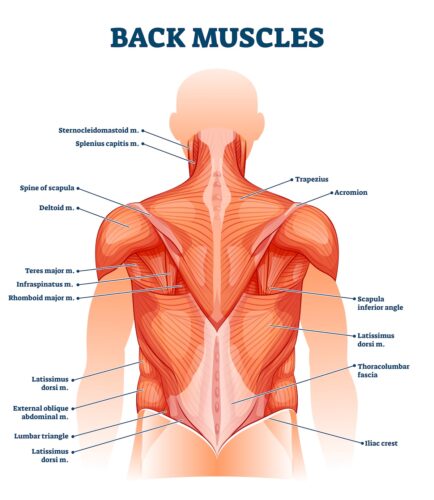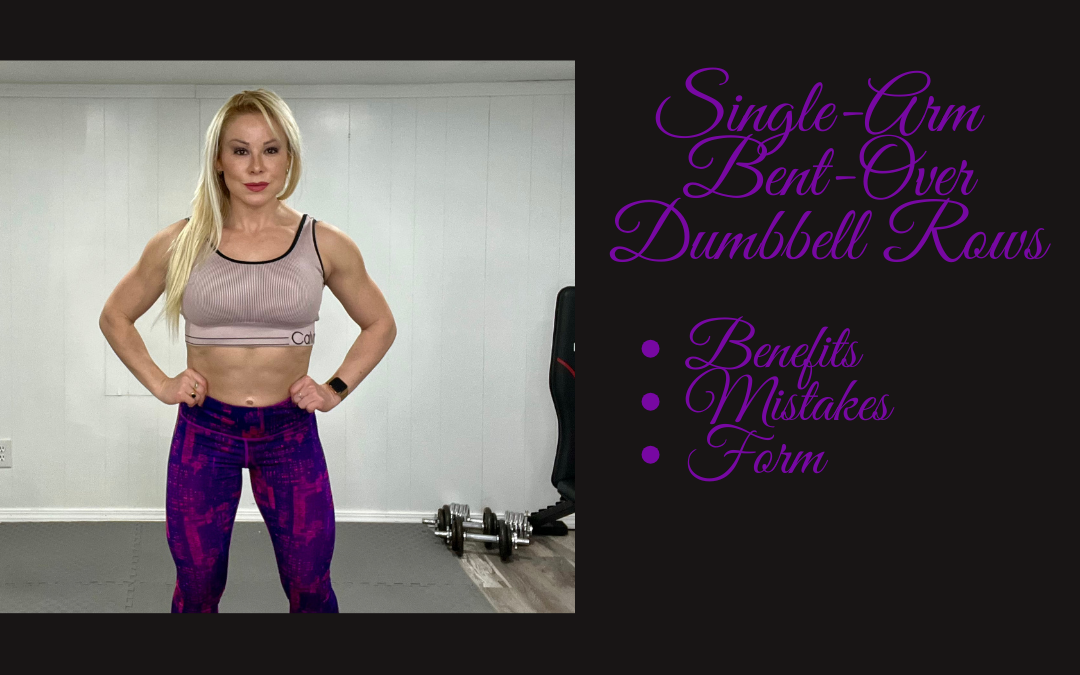Having a strong fit back is a prerequisite if you want to avoid back pain and other problems. Rows are amazing for your body, for your back specifically. As you know, diversity is key when aiming to achieve metabolic and physical changes in the body. A variation of the standard row is the single-arm bent-over dumbbell row. Let’s look into all the benefits and mistakes associated with this exercise, the muscles involved in the movement, and how to perform single-arm bent-over dumbbell rows.
What Muscles Do Single-Arm Bent-Over Dumbbell Rows Work?
The bent-over barbell row is a compound exercise that primarily targets the following muscles in the upper body:
- Latissimus Dorsi: These are the largest muscles in the back (on either side of the mid to lower back) and are responsible for a broad, V-shaped appearance. These are the primary muscles worked during the single-arm bent-over dumbbell row. They play the main role in the rowing movement and assist in climbing, swimming (especially during the downstroke), chopping, raising the trunk upwards, and compressing the thorax and abdomen.
- Rhomboids: These muscles are located between the shoulder blades, lying deep from the trapezius to the scapula. They are involved in pulling the shoulder blades together, retracting, elevating, and rotating the scapula.
- Erector Spinae: The muscles along the spine, lying in the groove to the side of the vertebral column. They are involved in maintaining an erect posture, back and head extension, forward flexion of the thorax, flexion, and rotation of the vertebral column and head.

The following are some secondary muscles involved in the movement:
- Biceps Brachii: These are the muscles in the front part of the upper arm. They help lift or lower the forearm, flex the elbow, flex the shoulder, and supinate the forearm. The underhand grip used in the underhand barbell row places additional emphasis on the biceps. While the primary focus is on the back muscles, the biceps act as synergists in the pulling movement.
- Trapezius: The traps are the broad, flat, superficial muscles on the posterior area of the neck and upper trunk. These muscles allow and support the spinal column to remain erect, help turn the head, elevate and depress the shoulders, internally rotate the arm, and optimize the scapula position. These muscles are engaged during the row, particularly the middle and lower portions, retracting and depressing the shoulder blades.
- Rear Deltoids: The rear deltoids are located on the posterior area of the shoulders. They play a secondary role in the single-arm bent-over dumbbell row.
Benefits of Single-Arm Bent-Over Dumbbell Rows
- Hypertrophy: Single-arm bent-over dumbbell rows help develop your back muscles.
- Strength: Simultaneously, this exercise contributes to improved back strength, essential during daily activities and for various functional movements.
- Muscle Symmetry & Balance: This exercise allows for a unilateral (one-sided) movement, which helps to engage and isolate each side of your back independently. This can allow you to develop better muscle symmetry and development, addressing any potential imbalances between your left and right sides.
- Improved Core Stability: Maintaining proper form during single-arm rows requires engagement of the core muscles to help support your spine and prevent excessive rotation. This can contribute to improved core stability and strength over time.
- Increased Range of Motion: Single-arm rows often allow for a greater range of motion compared to barbell rows. This increased range can result in better muscle activation and development, especially in the lats and upper back.
- Reduced Lower Back Strain: Compared to barbell rows, single-arm rows typically place less stress on the lower back. This can be beneficial for individuals with lower back issues or those who want to minimize strain on the lumbar spine while still targeting the upper back muscles effectively.
- Versatility: Single-arm bent-over dumbbell rows can be performed with different variations, such as using different grips, adjusting your body position, or incorporating pauses at the top or bottom of the movement. This versatility allows for customization based on individual preferences and goals.
- Enhanced Scapular Movement: The bent-over position of this exercise encourages scapular retraction and protraction, promoting a healthy range of motion in the shoulder blades. This is important for overall shoulder health and function.
- Functional Strength: As a compound movement, single-arm rows engage multiple muscle groups simultaneously, promoting functional strength that can be beneficial in daily activities and sports.
- Back Pain: Having strong back muscles prevents and helps you deal with back pain.
- Simplicity: This is a simple exercise that anyone can do. Plus, you only need a dumbbell to perform it.
How to Do Single-Arm Bent-Over Dumbbell Rows
Here’s how you can perform the single-arm bent-over dumbbell row with proper form:
- Stand with your feet shoulder-width apart.
- Grab a dumbbell in one hand and place the other one against a steady post or bench.
- Hinge at your hips to bend forward until your upper body is nearly parallel to the ground.
- You can just bend forward and maintain that position or place one knee on a bench.
- Keep your back straight, core engaged, and the arm holding the dumbbell hanging straight down
- As you exhale, pull the dumbbell towards your hip while keeping your elbow close to your body.
- As you inhale, lower the dumbbell back down in a controlled manner.
- Repeat for the desired amount of repetitions.

Single-Arm Bent-Over Dumbbell Rows‘ Mistakes
- Incorrect Spine Alignment: Rounding the back or hyperextending your back (arching it) can lead to lower back strain or injury. Try to maintain a straight and neutral spine throughout the movement, keeping your chest up and shoulders back.
- Using Very Heavy Weight: Using a weight that is too heavy can compromise your form. Choose a weight that allows you to perform the exercise properly, focusing on controlled movements.
- Incomplete Range of Motion: Not bringing the dumbbell as close to your hip as possible at the top of the movement or extending your arm down at the bottom of the movement doesn’t allow you to complete the exercise with a full range of motion.
- Improper Elbow Placement: Allowing your elbow to flare out to the side doesn’t allow you to engage the lats as effectively as possible. You should keep your elbow close to your body throughout the movement.
- Not Stabilizing the Non-Working Arm: It’s important to have your non-working arm supported on a bench or somewhere else so it is stable and helps you maintain balance.
- Using momentum: Jerking or swinging the weight can remove the tension from the targeted muscles. Instead, execute the movement in a slow and controlled manner and contract your muscles at the top.
- Looking Up or Down: Allowing your head to drop or look up can strain your neck. Keep your head in a neutral position, in line with your spine, in order to maintain proper spine alignment.
- Not Engaging Core Muscles: Neglecting to engage your core muscles can make you unstable. Instead, tighten your core muscles throughout the exercise so your spine is stable and you have more control over your body.
Single-Arm Bent-Over Dumbbell Row Video
Back Workout
You can complete your back workout with the following exercises:
As you can see the single-arm bent-over dumbbell row is a powerful back exercise that offers numerous benefits associated with back hypertrophy and strength, as well as overall back health and symmetry. Now that you know how to properly perform bent-over underhand barbell rows, you can avoid the most common mistakes associated with this exercise.
Lift, Burn more Fat, Get Stronger, and Live Healthier!
To a Fitter Healthier You,
The Fitness Wellness Mentor



